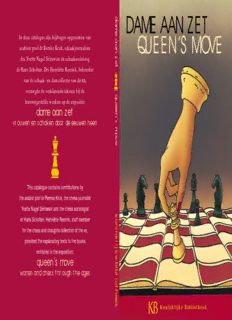
dame aan zet queen's move PDF
Preview dame aan zet queen's move
DAME AAN ZET d a m e QUEEN’S MOVE In deze catalogus zijn bijdragen opgenomen van a a arabiste prof dr Remke Kruk, schaakjournaliste n drs Yvette Nagel Seirawan en schaaksocioloog z e t dr Hans Scholten. Drs Henriëtte Reerink, beheerder van de schaak- en damcollectie van de KB, verzorgde de verklarende teksten bij de q tentoongestelde werken op de expositie: u dame aan zet e e n vrouwen en schaken door de eeuwen heen ’ s m o v e This catalogue contains contributions by the arabist prof dr Remke Kruk, the chess journalist Yvette Nagel Seirawan and the chess sociologist k dr Hans Scholten. Henriëtte Reerink, staff member o n for the chess and draughts collection of the KB, i n k provided the explanatory texts to the books l i j exhibited in the exposition: k queen’s move e b women and chess through the ages ib l i o t h e e k Koninklijke Bibliotheek queen’s move dame aan zet DAME AAN ZET vrouwen en schaken door de eeuwen heen QUEEN’S MOVE women and chess through the ages remke kruk yvette nagel seirawan henriëtte reerink hans scholten Koninklijke Bibliotheek• Den Haag 2000 queen’s move TENTOONSTELLINGSCATALOGIEN-BROCHURES VANDEKONINKLIJKEBIBLIOTHEEK Tentoonstelling van 28 augustus t/m 17 november 2000 Exhibition Koninklijke Bibliotheek August 28th to November 17th 2000 Queen’s Movewww.kb.nl UITGEVER|PUBLISHER Koninklijke Bibliotheek, Den Haag, 2000 SAMENSTELLING|COMPILEDBY Henriëtte Reerink BIJDRAGEN|CONTRIBUTIONS Remke Kruk, Yvette Nagel Seirawan, Hans Scholten VERTALING|TRANSLATION Lysbeth Croiset van Uchelen-Brouwer, Erik Geleijns, Nynke Leistra, Peter Thomson GRAFISCHONTWERP|GRAPHICDESIGN Geert Henderickx OMSLAGILLUSTRATIE|COVERILLUSTRATION Joost Veerkamp FOTO’S| PHOTOGRAPHY Optische technieken KB/ Optical Technology KB BUREAUREDACTIE|EDITORIALSTAFF Stafafdeling Communicatie | Corporate Communications Department LETTERTYPE|TYPEFACE Garamond Stempel, Copperplate DRUK|PRINTEDBY Enroprint bv, Rijswijk OPLAGE|NUMBEROFCOPIESPRINTED 500 ISSN0169-3557; 63 dame aan zet inhoud | contents 7 INLEIDING|INTRODUCTION 13 Remke Kruk EENDAME, EENPAARDENEENTORENVÓÓR Middeleeuwse schaaksters in Oost en West ALEADOFQUEEN, KNIGHTANDROOK Female chess players in the medieval East and West 35 Yvette Nagel Seirawan DAMEAANZET Een hobby, een beroep, een beleid QUEEN’SMOVE A hobby, a profession, a policy 57 Hans Scholten DEDAMEINZETDWANG Schakende vrouwen in de negentiende eeuw THEQUEENINZUGZWANG Female chess players in the 19th century 74 CATALOGUS| CATALOGUE henriëtte reerink inleiding introduction das schach hat wie die liebe, wie die musik die fähigkeit, den menschen glücklich zu machen. siegbert tarrasch (1862-1934) queen’s move 8 (cid:2) The chess collection in the Koninklijke Bibliotheek is one of the biggest and most beautiful in the world. It has been a privilege to put together an exhibition of books from this rich, inexhaustible collection. A choice was made for an exhibi- tion devoted to women and chess, a controversial and humorous subject reflec- ting a wide-ranging social development which is alluring to chess players and lay- men alike. The objective of the exhibition is to paint a general cultural historical picture rather than to give an overview of the history and the present state of af- fairs of women’s chess. The chess collection in the Koninklijke Bibliotheek was the starting point for putting together this exhibition. The Koninklijke Bibliotheek was already in the possession of a modest number of chess books when it acquired the collection of chess historian Antonius van der Linde in 1876. The collection became world famous when the well-known chess book collector Meindert Niemeijer bequeathed his private collection of 7000 titles to the library in 1948. The Bibliotheca Van der Linde-Niemeijerianawas born. From that moment onwards, the Koninklijke Bibliotheek has actively collect- ed chess books with the aim of maintaining as complete a chess collection as possible. The collection is marked by its diversity. All subjects that are related to chess are represented in the collection in a large number of languages. Do women play such an important role in chess that it justifies an exhibition? Until recently, this question could still be asked. But when the Hungarian Judit Polgar became the youngest Grandmaster ever at age 15 in 1991, all judgments and prejudices of women and chess seemed for a moment to have evaporated. Even the greatest sceptic was taken by the idea that the impossible might be- come possible: a female world champion. Judit Polgar is 23 years old, has an Elo-rating of 2658 (Kasparov’s rating, by comparison, is 2851 and Timman’s 2655) and is the number 30 on the world rank- ings. In january, 1996 she held the 10th place with a rating of 2675. Is she, to- gether with her sisters Zsuzsa and Szofia, the exception that makes the rule that women can play chess alright, but not as good as men? Was their talent for chess in their genes or was it bred by the specific education they received? These are questions the future will provide answers to. The exhibition Queen’s movesheds light on the past and gives a general cultur- al historical picture of women and chess. Roaming along a selection of the most beautiful works from the collection the visitor meets women playing chess in early Islamic culture and in medieval Western Europe, indiviual women chess players and their achievements, women in chess societies, views on chess-playing women and the image of women and chess in literature, art, caricature and ad- vertising. Remke Kruk, Yvette Nagel and Hans Scholten wrote articles for the catalogue that shed more light on important topics. I would like to thank them for their fas-
Description: